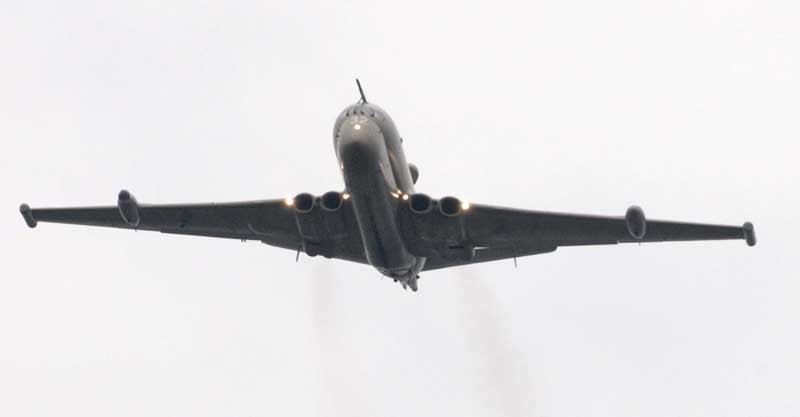A large crowd gathered at RAF Kinloss last week to bid farewell to the Nimrod MRA2 fleet after more than 30 years in the air.
The MR2 version took over in 1979 after its predecessor MR1 first started flying back in 1969, giving the ‘mighty hunter’ a very long air life.
Members of three squadrons — 120, 201 and 42R — gathered in a large hangar on the base to commemorate the service life of the remarkable aircraft.
One Nimrod pilot of 201 squadron said, “I am very sorry to see the MR2 go personally after seven years here.
“I am however looking forward to the MRA4 which will be a lot more capable aircraft with new wings, new engines and new avionics.
“These are already flying but it will be 2012 before they are fully operational.
“There will be nine MR4As opposed to the 13 MR2s we have on the station at the moment.
“The new engines will be more efficient and economic, allowing us to stay on our task much longer and we will be able to do much more.”
Kinloss station commander Group Captain Robbie Noel, said, “We are here today to reflect on 41 years’ service — tinged with sadness by the loss of 14 servicemen in Afghanistan when a Nimrod was lost.”
He added, “The Nimrod added value to almost every aspect of security in which it took part.”GapThe first of the new MRA4 aircraft has now been accepted and others will come into use this year and next year, but this will leave a gap in air sea rescue missions from the end of this month until the new aircraft is fully operational.
As part of the ceremony, the standards of the three squadrons were paraded to the pipes played by Pipe Major Barry Ashby before a flypast by two of the surviving MR2 aircraft, which was unhindered by the low cloud and foggy conditions.
Flt Lt Billy Speight gave the eulogy to the remarkable aircraft — aboard which he spent 12,000 of his 16,500 flying hours.
Air Vice Marshall Steve Hillier, Air Officer Commanding 2 Group, of which RAF Kinloss is part, said the MR2 had been a valuable aircraft and that he looked forward to its successor entering full service.
He believes that a fleet of nine MRA4s will be consistent with the tasks which they will have to carry out.
The MR2 was described as an “agile, capable and adaptable aircraft” which will be missed.
It has served in virtually every corner of the world and carried out missions over land and sea and retires as one of the most efficient maritime planes and submarine-hunters of all time.
Among the many notable landmarks in the long service of the MR2s were:1980 One of its first search and rescue (SAR) operations when the Alexander Keilland oil rig overturned in the North Sea with 280 people on board. 1982 Nimrods adapted for air to air refuelling and deployed to Ascension Island in the South Atlantic as part of the operation to retake the Falkland Islands. 1982 A Nimrod flew an 18-hour, 50-minute sortie, covering 8453 miles — the longest-distance operational maritime reconnaissance mission ever flown. 1985 Four Nimrods used to co-ordinate the search for the missing Air India 747 in the Atlantic. Remained on task for 21 hours. However, there were no survivors. 1988 Provided airborne co-ordination of SAR assets during Piper Alpha Disaster. Nimrods remained at the scene for 24 hours. The captain of the first Nimrod on scene was given an award in recognition of his role. 1995 Aircraft XV239 crashed while carrying out a display at the Toronto airshow. All seven crew on board were killed. 2002 until March 2009 Nimrods maintained a permanent presence in the Gulf in support of Operation Telic and Herrick. 2005 Nimrod dispatched dinghies and vectored in surface vessels to provide assistance to stricken yachts participating in the Transatlantic Race 200 miles from the Bay of Biscay. 2006 A Nimrod oversaw the evacuation of 130 oil workers following an electrical blaze on board the Tern Alpha oil platform, over 100 miles north-east of Shetland. 2006 Aircraft XV230 lost on operations over Afghanistan. All 12 crew plus two observers were killed. 2007 A Nimrod co-ordinated rescue vessels and helicopters in the search for survivors from Bourbon Dolphin, an offshore supply vessel which had overturned 70 miles north-west of Shetland. Seven crew were rescued but eight were lost. 2007 Nimrod co-ordinated seven helicopters evacuating 118 workers from Thistle Alpha platform 325 miles north of Aberdeen after a blaze. 2009 Nimrod went to the assistance of 18 offshore workers rescued when SuperPuma ditched in bad weather 500 yards from ETAP rig 120 miles east of Aberdeen. All survived.
